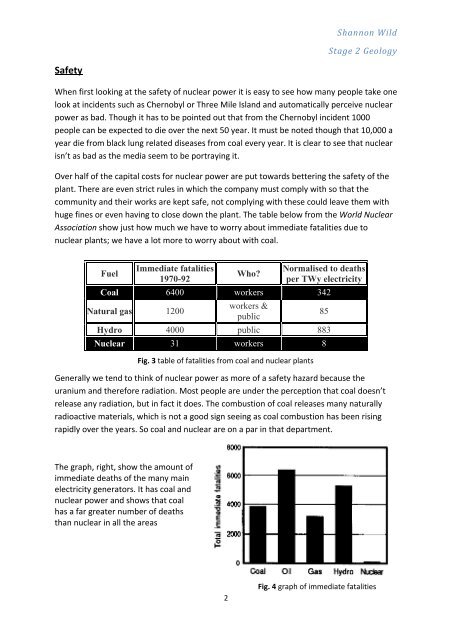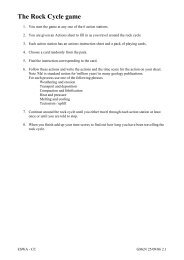Uranium as an Alternative to Fossil Fuel
Uranium as an Alternative to Fossil Fuel
Uranium as an Alternative to Fossil Fuel
You also want an ePaper? Increase the reach of your titles
YUMPU automatically turns print PDFs into web optimized ePapers that Google loves.
Sh<strong>an</strong>non Wild<br />
Stage 2 Geology<br />
Safety<br />
When first looking at the safety of nuclear power it is e<strong>as</strong>y <strong>to</strong> see how m<strong>an</strong>y people take one<br />
look at incidents such <strong>as</strong> Chernobyl or Three Mile Isl<strong>an</strong>d <strong>an</strong>d au<strong>to</strong>matically perceive nuclear<br />
power <strong>as</strong> bad. Though it h<strong>as</strong> <strong>to</strong> be pointed out that from the Chernobyl incident 1000<br />
people c<strong>an</strong> be expected <strong>to</strong> die over the next 50 year. It must be noted though that 10,000 a<br />
year die from black lung related dise<strong>as</strong>es from coal every year. It is clear <strong>to</strong> see that nuclear<br />
isn’t <strong>as</strong> bad <strong>as</strong> the media seem <strong>to</strong> be portraying it.<br />
Over half of the capital costs for nuclear power are put <strong>to</strong>wards bettering the safety of the<br />
pl<strong>an</strong>t. There are even strict rules in which the comp<strong>an</strong>y must comply with so that the<br />
community <strong>an</strong>d their works are kept safe, not complying with these could leave them with<br />
huge fines or even having <strong>to</strong> close down the pl<strong>an</strong>t. The table below from the World Nuclear<br />
Association show just how much we have <strong>to</strong> worry about immediate fatalities due <strong>to</strong><br />
nuclear pl<strong>an</strong>ts; we have a lot more <strong>to</strong> worry about with coal.<br />
<strong>Fuel</strong><br />
Immediate fatalities<br />
1970-92<br />
Who?<br />
Normalised <strong>to</strong> deaths<br />
per TWy electricity<br />
Coal 6400 workers 342<br />
Natural g<strong>as</strong> 1200<br />
workers &<br />
public<br />
Hydro 4000 public 883<br />
Nuclear 31 workers 8<br />
Fig. 3 table of fatalities from coal <strong>an</strong>d nuclear pl<strong>an</strong>ts<br />
Generally we tend <strong>to</strong> think of nuclear power <strong>as</strong> more of a safety hazard because the<br />
ur<strong>an</strong>ium <strong>an</strong>d therefore radiation. Most people are under the perception that coal doesn’t<br />
rele<strong>as</strong>e <strong>an</strong>y radiation, but in fact it does. The combustion of coal rele<strong>as</strong>es m<strong>an</strong>y naturally<br />
radioactive materials, which is not a good sign seeing <strong>as</strong> coal combustion h<strong>as</strong> been rising<br />
rapidly over the years. So coal <strong>an</strong>d nuclear are on a par in that department.<br />
85<br />
The graph, right, show the amount of<br />
immediate deaths of the m<strong>an</strong>y main<br />
electricity genera<strong>to</strong>rs. It h<strong>as</strong> coal <strong>an</strong>d<br />
nuclear power <strong>an</strong>d shows that coal<br />
h<strong>as</strong> a far greater number of deaths<br />
th<strong>an</strong> nuclear in all the are<strong>as</strong><br />
2<br />
Fig. 4 graph of immediate fatalities






